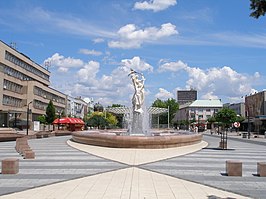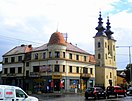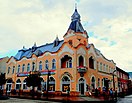Michalovce
Michalovce | |
|---|---|
Town | |
|
UTC+2 (CEST) | |
| Postal code | 071 01[2] |
| Area code | +421 56[2] |
| Car plate | MI |
| Website | http://www.michalovce.sk |
Michalovce (
The city is located on the shore of
History
Early history
The city of present-day Michalovce along with the adjacent lowlands was settled in from the
The town of Michalovce is the place where the legendary Prince Laborec died and was buried according to legends.
After the
Modern history
The 19th century brought back significant development of the town. In 1828, there were 49 craftsman workshops representing all 22 kinds of craft production of the crafts licences in the region of Zemplin. Until 1874 there were a few industrial factories of local importance in the surroundings of Michalovce (
More food-processing factories and industrial factories – a brewery, two brickworks and a steam millhouse – were established. Starting in 1876 doctors were employed in the town, as the Štefan Kukura Hospital was established that year. In 1896 the Hungarian language newspaper Felso Zemplén was published. In 1805 a common school is founded, which later changed into a state school. In 1804, a post office was established, and in 1873 a printing office was established.
In 1885, by a decision of the municipal council, a fire brigade was founded, and the first
After World War I, in 1918 (confirmed by the Treaty of Trianon in 1920), Michalovce, along with some other parts of Zemplén County, became part of the then-formed Czechoslovakia. In late summer and early autumn (August/September) 1944, 3500 Jewish inhabitants were deported from Michalovce. Since 1993, with the breakup of Czechoslovakia, Michalovce has been part of Slovakia. In 1996 it was made the seat of the Michalovce District.
The previous agricultural character of Michalovce was changed by a number of newly established industrial factories after 1945. In the 1950s and 1960s, factories processing agricultural products, and textile, engineering and construction companies arose. These included Agricultural Business and Supply Company, East-Slovak Dairy, East-Slovak Bakery and Confectionery, Slovak Malt Plant, East-Slovak Poultry Plant, Clothing Company and Odeta, a production company. During the early 1960s, construction of the Druzhba pipeline was a major source of employment.
Geography
The town lies in the Košice Region, in the Eastern Slovak Lowland on the Laborec river, historically belonging to Zemplén County. The town is about 48 km (30 mi) east of Košice and 30 km (19 mi) west of Uzhhorod, Ukraine. Geographical features nearby include the Vihorlat Mountains and the Zemplínska šírava lake. Nearby is the biggest lake of the Vihorlat Mountains, Morské oko, Vinné castle and Vinné lake.
Demographics
In 1910, Michalovce had 6120 residents, of whom 3792 were Hungarian, 1586 Slovak and 542 German. The religious makeup was 38.6% Roman Catholic, 32.3% Jewish and 23.2% Greek Catholic. After
According to the 2001
According to the 2011 census, the town had 40,027 inhabitants. 79.53% of the inhabitants were Slovaks, 3.09% were Roma, 0.39% were Czechs and 0.36% were Ukrainians. 15.47% did not specify a nationality.[10] The religious makeup was 42.07% Roman Catholics, 16.50% Greek Catholics, 3.96% Orthodox, 3.97% Evangelicals, 10.33% with no religious affiliation and 18.30% who did not specify affiliation.[10]
Education
The city of Michalovce is home to many secondary schools and some university colleges. Of the seven secondary schools, the most well-known and prestigious is the Pavol Horov Gymnasium. The other gymnasium is Gymnazium na ulici Ľudovita Štúra 26.
Health care
The largest health care provider in the municipality is the Štefan Kukura Hospital in Michalovce, with 712 beds.
Sport
The town has two professional top division clubs: football club MFK Zemplín Michalovce and ice hockey club HK Dukla Michalovce.
Twin towns — sister cities
Michalovce is
 Cognac, France
Cognac, France Jarosław, Poland
Jarosław, Poland Kavarna, Bulgaria
Kavarna, Bulgaria Liptovský Mikuláš, Slovakia
Liptovský Mikuláš, Slovakia Pančevo, Serbia
Pančevo, Serbia Sátoraljaújhely, Hungary
Sátoraljaújhely, Hungary Uzhhorod, Ukraine
Uzhhorod, Ukraine Villarreal, Spain
Villarreal, Spain Vyškov, Czech Republic
Vyškov, Czech Republic
Notable people
- Ivan Vladislav(the gravestone of a certain "Prince Presian" was found in Michalovce)
- Aurél Dessewffy (1808 at Nagy-Mihály – 1842), Hungarian journalist and politician.[12]
- Volodymyr Sichynskyi (1894 in Kamianets-Podilskyi – 1962) a Ukrainian émigré architect, graphic artist, and art historian.
- Emília Sičáková-Beblavá (born 1975 in Snina, Slovakia) a professor of Public Policy at the Comenius University in Bratislava.
- Matúš Šutaj Eštok (born 1987), politician.
References
- Notes
- ^ Statistical Office of the Slovak Republic (www.statistics.sk). "Hustota obyvateľstva - obce". www.statistics.sk. Retrieved 2024-02-08.
- ^ a b c d "Základná charakteristika". www.statistics.sk (in Slovak). Statistical Office of the Slovak Republic. 2015-04-17. Retrieved 2022-03-31.
- ^ Statistical Office of the Slovak Republic (www.statistics.sk). "Počet obyvateľov podľa pohlavia - obce (ročne)". www.statistics.sk. Retrieved 2024-02-08.
- ^ "Michalovce celebrates its namesakes". sme.sk. October 2011. Retrieved 20 August 2013.
- PMID 22673687.
- ^ Rustoiu, Aurel. "The Celts and Indigenous Populations from the Southern Carpathian Basin. Intercommunity Communication Strategies". Iron age rites and Rituals in the Carpathians Basin. www.Academia.edu. Retrieved 30 July 2013.
- ^ "Town history". Municipality of Michalovce. 2007. Retrieved 18 June 2009.
- ^ "Ethnic cleansing in post world war II Czechoslovakia: The presidential decrees of Edward Benes, 1945-1948". Human rights for minorities in Central Europe. Migration citizenship education. Archived from the original on 3 March 2012. Retrieved 30 July 2013.
- ^ a b "Municipal Statistics". Statistical Office of the Slovak republic. Archived from the original on 2007-11-16. Retrieved 2007-12-09.
- ^ a b "Nationality" (PDF). Statisticky Urad SR. Archived from the original (PDF) on 14 November 2013. Retrieved 12 July 2013.
- ^ "Družobné mestá" (in Slovak). Michalovce. Retrieved 2019-09-02.
- ^ Bain, Robert Nisbet (1911). . Encyclopædia Britannica. Vol. 8 (11th ed.). p. 104.






